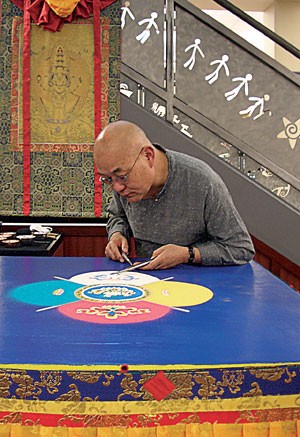On the bottom floor of the UofA Bookstore a Buddhist monk has been hunched over a table for hours creating a sacred symbol of compassion – using only sand.
Losang Samten became a Buddhist monk at the age of 11 and spent years in a monastery learning how to create these emblematic pieces of sand art known as mandalas.
Mandalas are generally round, symmetrical images that are created by lying and piling different colors of sand using metal funnels known as chakpos. The various colors of the sand represent the natural elements, symbolizing oneness with the earth.
While Samten has created mandalas for many different organizations, he enjoys creating them at universities to remind students to take a moment to calm down and relax.
“”The purpose of doing (a mandala) at a college like this, is that there is such high pressure and technology and catching up with something or finishing this,”” Samten said. “”A lot of people come to me and say, ‘You’re so patient, so patient.'””
The particular mandala that Samten is creating at the UA is said to invoke peace and compassion within the viewer.
This mandala will take Samten about six hours a day for six days to complete, yet there will be no trace of it when he finishes. In accordance with Buddhist tradition, once Samten has completed the image, the sand will be returned to earth following a dissolution ceremony.
Samten said he is not disappointed that there will be no physical testament to commemorate his time and effort.
According to the Buddhist tradition, the dissolution ceremony is used to illustrate the impermanence of all things and the belief that everything returns to the earth.
While it seems reasonable that spending hours upon hours focusing on tiny grains of sand without any evidence of completion would seem discouraging, Samten disagrees.
“”For me, mandalas are very joyful,”” he said. “”It’s a meditation.””
As a result of the extended amount of time mandalas take to create, the process is generally done with no fewer than four monks working simultaneously. Partly due to a lack of trained mandala artists, however, Samten has traveled the world producing these intricate works single-handedly.
“”Inside Tibet they no longer have training for mandalas, only in India,”” he said. “”There is becoming fewer and fewer and fewer.””
The lack of mandala training is a result of the Chinese occupation of Tibet in the 1950s. Since the occupation, the Tibetan Buddhists have not been allowed to practice religious ceremonies and as a result, many of these rituals, including that of the mandala are at risk of being lost.
Samten has served as a personal attendant to the current Dali Lama and spoke briefly about the Chinese-Tibetan conflict.
“”There’s so much difficulty in Tibet,”” he said. “”The Dali Lama says he wants more freedom – in Tibet if somebody cannot speak Chinese, they cannot find a job.””
The possibility that this unique ceremony could at some point become obsolete makes it all the more important to see it while you can, said Chris Schafer, program coordinator of the UofA Bookstore.
“”We want everyone on campus to come by and take a look at it, even if it’s just two minutes in between class,”” he said. “”A lot of people could go their whole life without getting a chance to see something like this.””
Mary Kay Thompson, a volunteer of the organization Arizona Friends of Tibet, also thinks students should come have a look and that Samten’s mandala is no doubt achieving its psychological purpose.
“”I think it generates a spirit of goodwill and compassion, just to get close to (the mandala), I feel it,”” said Thompson. “”I hope it will spread through the world and make just some little bit of difference.””
Samten will continue to create his mandala from 10 a.m. to 5 p.m. for the rest of the week and will hold a dissolution ceremony on Saturday at 11 a.m.
His progress can be viewed 24 hours a day on the UofA Bookstore Web site via live Web cam.
He creates this image for peace and compassion and it’s to go back to the earth and to bless the earth, it’s not for his benefit, it’s for the benefit of everybody.









